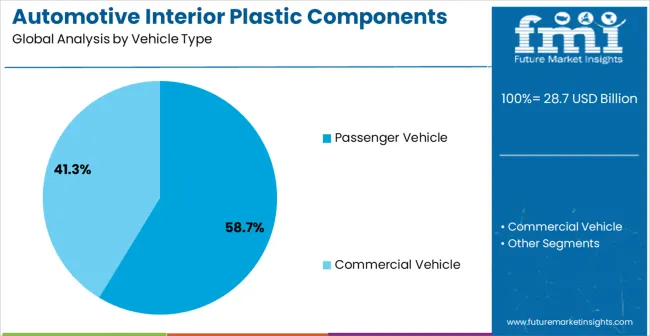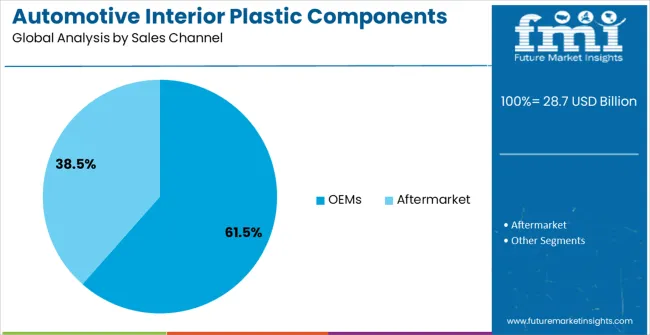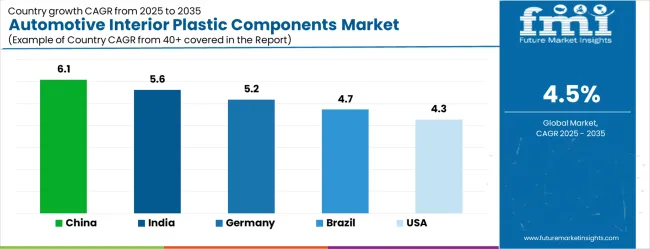The Automotive Interior Plastic Components Market is estimated to be valued at USD 28.7 billion in 2025 and is projected to reach USD 44.6 billion by 2035, registering a compound annual growth rate (CAGR) of 4.5% over the forecast period.

| Metric | Value |
|---|---|
| Automotive Interior Plastic Components Market Estimated Value in (2025 E) | USD 28.7 billion |
| Automotive Interior Plastic Components Market Forecast Value in (2035 F) | USD 44.6 billion |
| Forecast CAGR (2025 to 2035) | 4.5% |
The Automotive Interior Plastic Components market is experiencing robust growth, driven by increasing demand for lightweight, durable, and cost-effective interior solutions in vehicles. Rising production of passenger vehicles, coupled with the automotive industry's focus on fuel efficiency and emission reduction, is fueling the adoption of advanced plastic materials in interiors. Innovations in polymer technology, including high-performance polypropylene, thermoplastic elastomers, and composite blends, are enhancing durability, aesthetics, and safety standards.
Manufacturers are increasingly integrating plastic components in dashboards, door panels, center consoles, and seating systems to reduce vehicle weight and improve design flexibility. The growing emphasis on comfort, noise reduction, and interior customization is further boosting demand. Additionally, regulatory mandates on weight reduction and sustainability are encouraging the use of recyclable and lightweight plastic materials.
As passenger vehicle production rises in emerging and developed markets, and consumer preference shifts toward enhanced comfort and premium interiors, the Automotive Interior Plastic Components market is expected to witness sustained growth Continuous innovation in material science, manufacturing processes, and modular design solutions will remain key growth drivers.
The automotive interior plastic components market is segmented by vehicle type, product type, sales channel, and geographic regions. By vehicle type, automotive interior plastic components market is divided into Passenger Vehicle and Commercial Vehicle. In terms of product type, automotive interior plastic components market is classified into Polypropylene (PP), Polyurethane (PU), Polyvinyl Chloride (PVC), Acrylonitrile Butadiene Styrene (ABS), Poly Carbonates (PC), and Others. Based on sales channel, automotive interior plastic components market is segmented into OEMs and Aftermarket. Regionally, the automotive interior plastic components industry is classified into North America, Latin America, Western Europe, Eastern Europe, Balkan & Baltic Countries, Russia & Belarus, Central Asia, East Asia, South Asia & Pacific, and the Middle East & Africa.

The passenger vehicle segment is projected to hold 58.7% of the market revenue in 2025, establishing it as the leading vehicle type. Growth in this segment is being driven by the expanding production and sales of passenger cars globally, particularly in emerging economies where urbanization and rising disposable income are increasing vehicle ownership. Interior plastic components are widely used in dashboards, door trims, seating structures, and center consoles to enhance durability, aesthetics, and overall comfort.
Advanced polymer materials such as polypropylene and thermoplastic blends provide high impact resistance, lightweight properties, and design versatility, making them ideal for passenger vehicle interiors. Manufacturers are increasingly adopting these materials to meet fuel efficiency targets and regulatory requirements on emission reduction.
The ability to combine cost-effectiveness with performance and design flexibility further supports adoption As automotive OEMs prioritize enhanced interiors and lightweight designs, the passenger vehicle segment is expected to maintain its leading position, reinforced by ongoing technological improvements and rising consumer expectations for quality, safety, and comfort.

The polypropylene product type segment is expected to account for 39.6% of the market revenue in 2025, making it the leading material choice. Growth is being driven by the material's favorable properties, including lightweight structure, high chemical resistance, and versatility in manufacturing processes such as injection molding and thermoforming. Polypropylene enables the production of interior components with superior impact strength, dimensional stability, and surface finish, meeting the functional and aesthetic requirements of modern vehicles.
Its recyclability and cost-effectiveness further enhance adoption, particularly as OEMs and suppliers focus on sustainability and environmental compliance. Polypropylene also allows for enhanced design flexibility, enabling complex shapes and integration of multiple functionalities into a single component, reducing assembly complexity and costs.
Increasing demand for high-quality interiors that balance durability, comfort, and lightweight design continues to propel the use of polypropylene in passenger vehicles and other automotive segments Continuous material innovation and improved processing techniques are expected to sustain the segment’s leadership in the market.

The OEMs sales channel segment is projected to hold 61.5% of the market revenue in 2025, establishing it as the leading distribution channel. Growth is being driven by the increasing trend of automakers sourcing interior plastic components directly from suppliers to ensure quality, design consistency, and compliance with safety and regulatory standards.
OEM partnerships allow for close collaboration in material selection, component design, and process optimization, resulting in efficient manufacturing and integration of components into vehicles. Direct supply to OEMs also reduces inventory costs, enhances production planning, and enables timely delivery of components in line with vehicle assembly schedules.
The segment’s dominance is further reinforced by long-term contracts, strong relationships between automotive manufacturers and component suppliers, and growing focus on high-performance, lightweight materials As automotive production continues to expand, particularly for passenger vehicles, OEMs are expected to remain the primary sales channel for interior plastic components, supported by technological advancements and the demand for optimized vehicle interiors.
Plastic is the most suitable material for use in the automotive industry due to its beneficial properties like scratch resistance, high volume to weight resistance, thermal stability and impact resistance. These properties in turn ease the operation for automotive component manufacturers by reducing the cycle time for moulding, and reducing the assembly time for OEMs.
Furthermore, shifting consumer preference for passenger cars with an attractive appearance and upgraded aerodynamic shape is pushing manufacturer to use materials like advanced plastic which are easier to mould to desired shape than other materials.
On other hand, growing demand for fuel efficient vehicles, component manufacturers are continuously innovating lightweight automotive components with advanced plastic material owning until they help to improve the functionality, appearance, and safety of automobiles, while delivering the superior value to consumers.
The use of new and upgraded automotive components, such as a navigation panel and rear vehicle infotainment system, is increasing significantly in the premium and mid-range passenger car segments. These components are generally made up of advanced plastic materials, and the aftermarket for such augmented products is increasing in Brazil with the increasing number of vehicles in operation (personal car and in-transit/cab-services). For instance, BMW’s i3, is an innovative electric car which is built with a lightweight carbon fiber and advanced plastic material.

| Country | CAGR |
|---|---|
| China | 6.1% |
| India | 5.6% |
| Germany | 5.2% |
| Brazil | 4.7% |
| USA | 4.3% |
| UK | 3.8% |
| Japan | 3.4% |
The Automotive Interior Plastic Components Market is expected to register a CAGR of 4.5% during the forecast period, exhibiting varied country level momentum. China leads with the highest CAGR of 6.1%, followed by India at 5.6%. Developed markets such as Germany, France, and the UK continue to expand steadily, while the USA is likely to grow at consistent rates. Japan posts the lowest CAGR at 3.4%, yet still underscores a broadly positive trajectory for the global Automotive Interior Plastic Components Market. In 2024, Germany held a dominant revenue in the Western Europe market and is expected to grow with a CAGR of 5.2%. The USA Automotive Interior Plastic Components Market is estimated to be valued at USD 10.1 billion in 2025 and is anticipated to reach a valuation of USD 10.1 billion by 2035. Sales are projected to rise at a CAGR of 0.0% over the forecast period between 2025 and 2035. While Japan and South Korea markets are estimated to be valued at USD 1.5 billion and USD 980.5 million respectively in 2025.
| Item | Value |
|---|---|
| Quantitative Units | USD 28.7 Billion |
| Vehicle Type | Passenger Vehicle and Commercial Vehicle |
| Product Type | Polypropylene (PP), Polyurethane (PU), Polyvinyl Chloride (PVC), Acrylonitrile Butadiene Styrene (ABS), Poly Carbonates (PC), and Others |
| Sales Channel | OEMs and Aftermarket |
| Regions Covered | North America, Europe, Asia-Pacific, Latin America, Middle East & Africa |
| Country Covered | United States, Canada, Germany, France, United Kingdom, China, Japan, India, Brazil, South Africa |
| Key Companies Profiled | Saudi Basic Industries Corporation (SABIC), Smiths Plastics, Plastikon Industries, National Plastics, Grupo Antolin, MVC Holdings, Barkley Plastics, Plastic Molding Technology, Productive Plastics, Tata Sons, Nifco, Dipty Lal Judge Mal, and Covestro |
The global automotive interior plastic components market is estimated to be valued at USD 28.7 billion in 2025.
The market size for the automotive interior plastic components market is projected to reach USD 44.6 billion by 2035.
The automotive interior plastic components market is expected to grow at a 4.5% CAGR between 2025 and 2035.
The key product types in automotive interior plastic components market are passenger vehicle and commercial vehicle.
In terms of product type, polypropylene (pp) segment to command 39.6% share in the automotive interior plastic components market in 2025.






Our Research Products

The "Full Research Suite" delivers actionable market intel, deep dives on markets or technologies, so clients act faster, cut risk, and unlock growth.

The Leaderboard benchmarks and ranks top vendors, classifying them as Established Leaders, Leading Challengers, or Disruptors & Challengers.

Locates where complements amplify value and substitutes erode it, forecasting net impact by horizon

We deliver granular, decision-grade intel: market sizing, 5-year forecasts, pricing, adoption, usage, revenue, and operational KPIs—plus competitor tracking, regulation, and value chains—across 60 countries broadly.

Spot the shifts before they hit your P&L. We track inflection points, adoption curves, pricing moves, and ecosystem plays to show where demand is heading, why it is changing, and what to do next across high-growth markets and disruptive tech

Real-time reads of user behavior. We track shifting priorities, perceptions of today’s and next-gen services, and provider experience, then pace how fast tech moves from trial to adoption, blending buyer, consumer, and channel inputs with social signals (#WhySwitch, #UX).

Partner with our analyst team to build a custom report designed around your business priorities. From analysing market trends to assessing competitors or crafting bespoke datasets, we tailor insights to your needs.
Supplier Intelligence
Discovery & Profiling
Capacity & Footprint
Performance & Risk
Compliance & Governance
Commercial Readiness
Who Supplies Whom
Scorecards & Shortlists
Playbooks & Docs
Category Intelligence
Definition & Scope
Demand & Use Cases
Cost Drivers
Market Structure
Supply Chain Map
Trade & Policy
Operating Norms
Deliverables
Buyer Intelligence
Account Basics
Spend & Scope
Procurement Model
Vendor Requirements
Terms & Policies
Entry Strategy
Pain Points & Triggers
Outputs
Pricing Analysis
Benchmarks
Trends
Should-Cost
Indexation
Landed Cost
Commercial Terms
Deliverables
Brand Analysis
Positioning & Value Prop
Share & Presence
Customer Evidence
Go-to-Market
Digital & Reputation
Compliance & Trust
KPIs & Gaps
Outputs
Full Research Suite comprises of:
Market outlook & trends analysis
Interviews & case studies
Strategic recommendations
Vendor profiles & capabilities analysis
5-year forecasts
8 regions and 60+ country-level data splits
Market segment data splits
12 months of continuous data updates
DELIVERED AS:
PDF EXCEL ONLINE
Automotive Direct Liquid Cooling IGBT Module Market Size and Share Forecast Outlook 2025 to 2035
Automotive Hoses and Assemblies Market Size and Share Forecast Outlook 2025 to 2035
Automotive Network Testing Market Size and Share Forecast Outlook 2025 to 2035
Automotive Performance Part Market Size and Share Forecast Outlook 2025 to 2035
Automotive Carbon Ceramic Brake Market Size and Share Forecast Outlook 2025 to 2035
Automotive Camshaft Market Size and Share Forecast Outlook 2025 to 2035
Automotive Stamping Industry Analysis in India Size and Share Forecast Outlook 2025 to 2035
Automotive Cylinder Liner Market Size and Share Forecast Outlook 2025 to 2035
Automotive Microcontroller Market Size and Share Forecast Outlook 2025 to 2035
Automotive Roof Rails Market Size and Share Forecast Outlook 2025 to 2035
Automotive Active Safety System Market Size and Share Forecast Outlook 2025 to 2035
Automotive Diagnostic Scan Tool Market Size and Share Forecast Outlook 2025 to 2035
Automotive Test Equipment Market Size and Share Forecast Outlook 2025 to 2035
Automotive Dynamic Map Data Market Size and Share Forecast Outlook 2025 to 2035
Automotive Green Tires Market Size and Share Forecast Outlook 2025 to 2035
Automotive E-Tailing Market Size and Share Forecast Outlook 2025 to 2035
Automotive Key Market Size and Share Forecast Outlook 2025 to 2035
Automotive Appearance Chemical Market Forecast and Outlook 2025 to 2035
Automotive Seating Market Forecast and Outlook 2025 to 2035
Automotive Domain Control Module Market Forecast and Outlook 2025 to 2035

Thank you!
You will receive an email from our Business Development Manager. Please be sure to check your SPAM/JUNK folder too.
Chat With
MaRIA